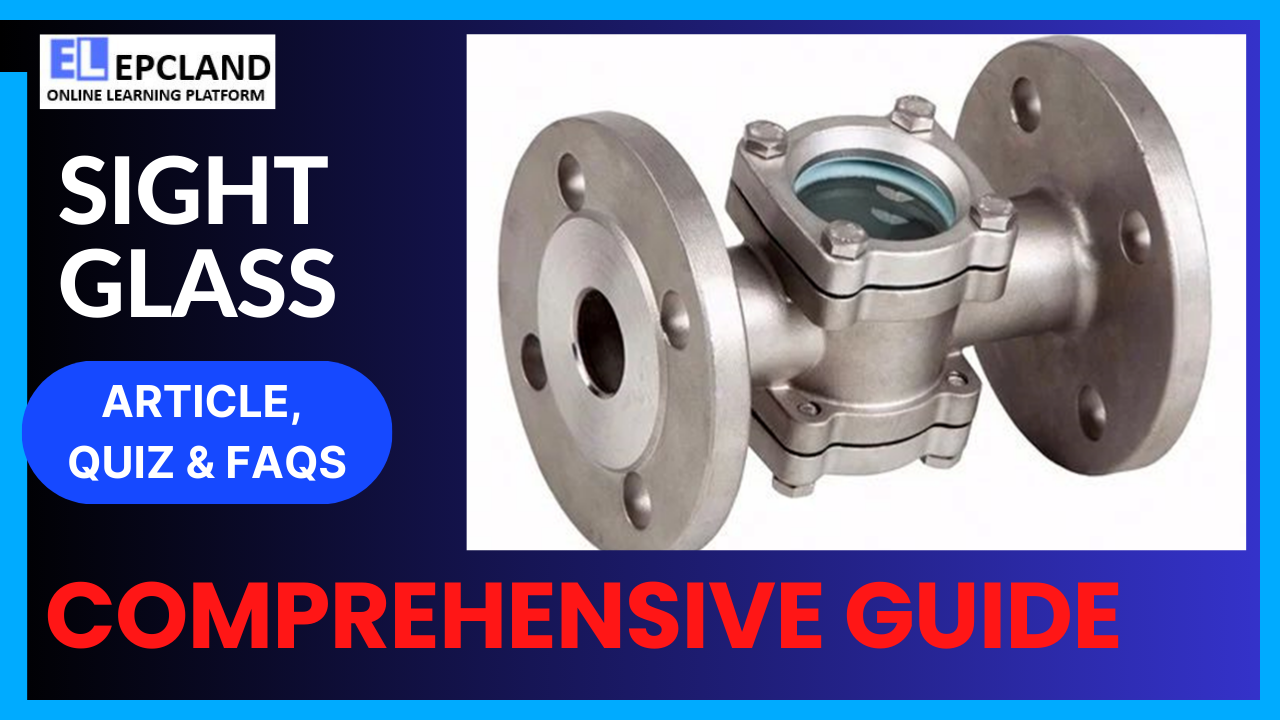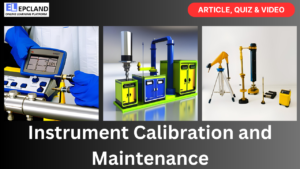1. Introduction
Sight glasses, a fundamental component in the realm of industrial processes, have significantly revolutionized the way the oil and gas industry operates. These transparent windows into the heart of intricate machinery offer unparalleled insights, ensuring seamless operations, enhancing safety protocols, and enabling efficient maintenance practices. In this comprehensive guide, we delve deep into the world of sight glasses, exploring their historical evolution, understanding their basic functions, dissecting their various types, and elucidating their applications in the oil and gas sector. Additionally, we analyze their advantages and disadvantages, emphasizing the critical importance of adhering to international codes and standards.
Table of Contents
Don’t miss the Complete Course on Piping Engineering: Check Now
Enrollment Link
2. Brief History
The origins of sight glasses can be traced back to the early days of the industrial revolution when the need for real-time monitoring within machinery became apparent. Early versions were rudimentary, often made from thick glass encased in metal frames. Over time, advancements in materials and manufacturing techniques led to the development of more sophisticated sight glasses, which found their way into diverse industrial sectors. In the oil and gas industry, their integration proved revolutionary, transforming the way engineers and operators approached the monitoring and maintenance of critical equipment.
3. Basic Function and Working Principle
At its core, a sight glass is a transparent window embedded within a sealed chamber. Its primary function is to allow visual inspection of the internal components of a system without compromising its integrity. The working principle of a sight glass involves the use of high-strength transparent materials, such as tempered glass or certain plastics, that can withstand the harsh operating conditions within industrial equipment. These materials are carefully sealed to prevent leakage, ensuring a clear view while maintaining the integrity of the system.
4. Main Components & Their Functions
Glass: The glass component of a sight glass is typically made from materials that are resistant to corrosion, high temperatures, and mechanical stress. Borosilicate glass, for instance, is commonly used due to its exceptional durability and transparency. The glass provides a clear view into the system, allowing operators to monitor processes in real-time.
Gaskets: Gaskets are essential components that ensure a tight seal between the glass and the surrounding frame. They are usually made from materials like rubber or silicone, chosen for their ability to withstand varying temperatures and pressures. Proper gaskets prevent leakage, maintaining the structural integrity of the sight glass assembly.
Frames: The frame serves as the housing for the glass and gaskets, holding them securely in place within the system. Frames are typically made from metals like stainless steel, ensuring both strength and resistance to corrosion. The design of the frame also plays a role in providing protection to the glass, especially in environments where the sight glass might be exposed to external forces or contaminants.
Seals: Seals, often made from elastomeric materials, are crucial for preventing leaks between the sight glass and the equipment it is installed in. They create a watertight and airtight barrier, ensuring that the system remains sealed while allowing operators a clear view of the internal processes.

5. Types of Sight Glasses
Sight glasses come in various types, each designed to cater to specific industrial requirements.
Overview of Sight Glass Types
| Sight Glass Type | Description |
|---|---|
| Flat Type | Simple design for direct, unobstructed views. |
| Tubular Type | Cylindrical tube for continuous monitoring of fluid levels and flow. |
| Reflex Type | Prismatic grooves create contrast, ideal for accurate level determination. |
| DIN Type | Standardized dimensions, widely used in various industrial applications. |
Flat Type: Flat sight glasses are characterized by their straightforward design, featuring a flat transparent window set within a frame. They are commonly used in applications where a direct, unobstructed view of the internal components is necessary, allowing for precise visual inspection.
Tubular Type: Tubular sight glasses consist of a cylindrical tube made from tempered glass or other transparent materials. These glasses are ideal for applications where continuous monitoring of fluid levels or flow is essential. The transparent tube allows operators to observe the movement, color, and clarity of the fluid, providing valuable insights into the system’s performance.
Reflex Type: Reflex sight glasses are designed with prismatic grooves on one side of the glass, creating a contrast between the liquid and the air interface. This contrast makes it easier to distinguish the boundary between the two phases, making reflex sight glasses particularly useful in applications where the exact level of a liquid needs to be determined quickly and accurately.
DIN Type: DIN sight glasses adhere to specific standards set by the German Institute for Standardization (DIN). These sight glasses are widely used in various industrial sectors, including oil and gas, due to their standardized dimensions and compatibility with DIN-standardized equipment.
Don’t miss the Complete Course on Piping Engineering: Check Now
Enrollment Link
6. Applications of Sight Glasses
Sight glasses find extensive applications in the oil and gas industry, playing a crucial role in diverse processes and equipment.
Pipelines: Sight glasses installed in pipelines allow operators to monitor the flow of fluids, ensuring that there are no blockages or irregularities. By observing the color, consistency, and flow rate of the fluids, operators can quickly detect potential issues, enabling timely interventions to prevent downtime or accidents.
Tanks and Reactors: Sight glasses are commonly integrated into tanks and reactors to provide real-time visibility into the contents. Monitoring the level and characteristics of the substances inside these vessels is vital for ensuring optimal reactions and preventing overflows or equipment failures. Sight glasses enable operators to assess the state of the contents without the need for physical inspections, enhancing both efficiency and safety.
Compressors and Pumps: In compressors and pumps, sight glasses are used to monitor lubricant levels and the overall condition of the internal components. By observing the movement and color of the lubricating oil, operators can assess the health of the machinery. This visual inspection is instrumental in identifying signs of wear, contamination, or inadequate lubrication, allowing for timely maintenance and preventing costly breakdowns.
Heat Exchangers: Sight glasses installed in heat exchangers enable operators to observe the heat transfer process and detect any issues such as fouling or leaks. Monitoring the flow patterns and the clarity of the fluids inside the exchanger helps maintain efficient heat exchange, ensuring optimal performance and energy efficiency.
7. Advantages & Disadvantages
Advantages:
- Real-time Monitoring: Sight glasses provide instant visual feedback, allowing operators to monitor processes continuously.
- Early Fault Detection: Operators can quickly identify abnormalities or issues, enabling prompt corrective actions.
- Easy Maintenance: Visual inspections simplify maintenance procedures, reducing downtime and operational disruptions.
- Enhanced Safety: By enabling real-time monitoring without physical intervention, sight glasses contribute to the safety of operators and the overall facility.
- Cost-Effectiveness: Early detection of problems and efficient maintenance translate to cost savings in the long run.
Disadvantages:
- Susceptibility to Damage: Sight glasses are vulnerable to mechanical damage, especially in high-impact environments.
- Limited Visibility in Certain Conditions: Factors such as high temperatures, extreme pressures, or the presence of opaque substances can impair visibility.
- Maintenance Challenges: While sight glasses simplify routine inspections, they require proper maintenance themselves to ensure longevity and accuracy.
8. Codes & Standards of Sight Glasses
Adherence to international codes and standards is paramount in the manufacturing, installation, and use of sight glasses within the oil and gas industry.
- API (American Petroleum Institute): API standards ensure the quality and reliability of sight glasses used in oil and gas applications. These standards cover aspects such as materials, dimensions, and testing procedures, providing a comprehensive framework for manufacturers and users.
- ASME (American Society of Mechanical Engineers): ASME standards set guidelines for the design, fabrication, and inspection of sight glasses. Compliance with ASME standards ensures that sight glasses meet rigorous criteria for safety and performance, instilling confidence in their reliability.
- ASTM (American Society for Testing and Materials): ASTM standards provide specifications for the materials used in sight glasses, ensuring their durability, resistance to corrosion, and other essential properties. These standards are essential for manufacturers to produce high-quality, reliable sight glasses.
Don’t miss the Complete Course on Piping Engineering: Check Now
Enrollment Link
9. Conclusion
In conclusion, sight glasses stand as indispensable assets in the oil and gas industry, enabling operators to navigate the complex world of industrial processes with precision and confidence. Their evolution from rudimentary designs to sophisticated, specialized components mirrors the advancement of industrial technologies. By offering real-time monitoring, early fault detection, and simplified maintenance procedures, sight glasses contribute significantly to the efficiency, safety, and cost-effectiveness of operations.
As technology continues to advance, sight glasses are poised to evolve further, incorporating innovations such as smart sensors and augmented reality interfaces. These developments will undoubtedly enhance their capabilities, further optimizing industrial processes and ensuring the seamless operation of critical equipment. In this ever-changing landscape, adherence to international codes and standards remains paramount, serving as the foundation for the reliability and effectiveness of sight glasses in the oil and gas industry.
The journey of sight glasses, from humble beginnings to becoming integral components of modern industrial processes, reflects the relentless pursuit of excellence in engineering and innovation. As industries continue to push the boundaries of what is possible, sight glasses will undoubtedly remain at the forefront, providing the essential visibility that empowers operators to navigate the intricate complexities of the oil and gas sector with unparalleled clarity and efficiency.
FAQs
1. What are the key factors to consider when choosing a sight glass for specific applications in the oil and gas industry?
Selecting an appropriate sight glass involves considering factors such as the operating temperature and pressure, the nature of the fluids being monitored, visibility requirements, and environmental conditions. Each of these factors influences the choice of materials, type, and design of the sight glass to ensure optimal performance and longevity in the intended application.
2. How do reflex sight glasses work, and in what scenarios are they particularly beneficial compared to other types of sight glasses?
Reflex sight glasses utilize prismatic grooves to create a visible contrast between the liquid and the air interface, allowing for precise level determination. They are particularly useful in applications where accurate level readings are crucial, such as in tanks with varying fluid levels. Reflex sight glasses provide quick and reliable information about the fluid level without the need for complex measurements, making them valuable in scenarios where efficiency and accuracy are paramount.
3. What maintenance practices are essential to prolong the lifespan of sight glasses in industrial settings, especially considering their susceptibility to damage?
Proper maintenance is crucial to ensuring the longevity and functionality of sight glasses. Regular inspections for signs of wear, cleaning to prevent obstructions, and timely replacement of damaged gaskets or seals are essential practices. Additionally, implementing protective measures, such as shields or guards, in high-impact environments can significantly reduce the risk of damage. Following manufacturer-recommended maintenance schedules and guidelines is fundamental in preserving the integrity of sight glasses.
4. How are sight glasses evolving with advancements in technology, and what role do smart sensors play in enhancing their functionality?
Advancements in technology have led to the integration of smart sensors into sight glasses, enabling real-time data collection and analysis. These sensors can provide additional information, such as temperature, pressure, or fluid composition, enhancing the monitoring capabilities of sight glasses. IoT (Internet of Things) integration allows for remote monitoring, predictive maintenance, and data-driven decision-making, leading to more efficient and cost-effective industrial processes. Understanding these technological advancements is crucial for industries aiming to stay at the forefront of innovation.
5. In the context of international codes and standards, how do sight glass manufacturers ensure their products meet the required specifications, and what role do these standards play in ensuring the safety and reliability of sight glasses in the oil and gas industry?
Sight glass manufacturers adhere to rigorous testing and quality control processes to meet international codes and standards such as API, ASME, and ASTM. These standards define specific requirements for materials, dimensions, fabrication, and testing procedures. By complying with these standards, manufacturers ensure that their products meet industry benchmarks for safety, performance, and reliability. Additionally, adherence to these standards provides confidence to operators and engineers, guaranteeing that the sight glasses installed in critical industrial equipment meet the necessary criteria for optimal functionality and operational safety.
Recommended courses (Published on EPCLand)
- Basics of Piping Engineering
- Piping Layout Engineering
- Piping Material Engineering
- Piping Stress Analysis
- Complete Course on Piping Engineering
- Material Requisitions
- Piping Material Specifications
- Valve Material Specifications
Don’t miss the published articles on following:
Don’t miss the Complete Course on Piping Engineering: Check Now
Enrollment Link
Attempt Quiz
Question 1:
What is the primary purpose of a sight glass in the Oil & Gas Industry?
Explanation: Sight glasses in the Oil & Gas Industry are primarily used to monitor fluid levels in tanks and pipelines.
Question 2:
What material is commonly used for manufacturing sight glasses?
Explanation: Sight glasses are commonly made from materials like glass or stainless steel for durability and clarity.
Question 3:
What is the function of a sight glass with a wiper?
Explanation: Sight glasses with wipers are used to enhance visibility in harsh conditions, such as when the glass becomes dirty or foggy.
Question 4:
What is the purpose of a sight glass in a pressure vessel?
Explanation: Sight glasses in pressure vessels are used to inspect internal conditions, ensuring safety and maintenance.
Question 5:
Which type of sight glass is suitable for high-pressure applications?
Explanation: Reflex sight glasses are suitable for high-pressure applications due to their robust design and ability to withstand pressure variations.
Question 6:
What is the purpose of a sight glass with a lighting arrangement?
Explanation: Sight glasses with lighting arrangements provide illumination in dark environments, ensuring clear visibility.
Question 7:
What is the advantage of a flanged sight glass?
Explanation: Flanged sight glasses are advantageous because they can be easily removed for cleaning and maintenance without dismantling the entire system.
Question 8:
Which factor is crucial for selecting the right sight glass for corrosive fluids?
Explanation: The material compatibility of the sight glass with the corrosive fluid is crucial to prevent corrosion and ensure long-term functionality.
Question 9:
What is the function of a sight glass in a separator vessel?
Explanation: Sight glasses in separator vessels are used to observe phase separation between different components of the fluid.
Question 10:
What is the purpose of using a sight glass with a magnifying feature?
Explanation: Sight glasses with a magnifying feature enlarge the view, allowing for detailed observation of the fluid and its characteristics.



